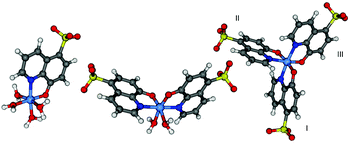NMR, DFT and luminescence studies of the complexation of Al(iii) with 8-hydroxyquinoline-5-sulfonate†
Abstract
Multinuclear (1H, 13C and 27Al) magnetic resonance

* Corresponding authors
a Departamento de Química, Universidade de Coimbra, 3004-535 Coimbra, Portugal
b
Centro de Neurociências e Biologia Celular, Universidade de Coimbra, Portugal
E-mail:
mlramos@ci.uc.pt
Fax: +351-239-827703
Tel: +351-239-854453
Multinuclear (1H, 13C and 27Al) magnetic resonance

 Please wait while we load your content...
Something went wrong. Try again?
Please wait while we load your content...
Something went wrong. Try again?
M. L. Ramos, L. L. G. Justino, A. I. N. Salvador, A. R. E. de Sousa, P. E. Abreu, S. M. Fonseca and H. D. Burrows, Dalton Trans., 2012, 41, 12478 DOI: 10.1039/C2DT31381B
To request permission to reproduce material from this article, please go to the Copyright Clearance Center request page.
If you are an author contributing to an RSC publication, you do not need to request permission provided correct acknowledgement is given.
If you are the author of this article, you do not need to request permission to reproduce figures and diagrams provided correct acknowledgement is given. If you want to reproduce the whole article in a third-party publication (excluding your thesis/dissertation for which permission is not required) please go to the Copyright Clearance Center request page.
Read more about how to correctly acknowledge RSC content.
 Fetching data from CrossRef.
Fetching data from CrossRef.
This may take some time to load.
Loading related content
